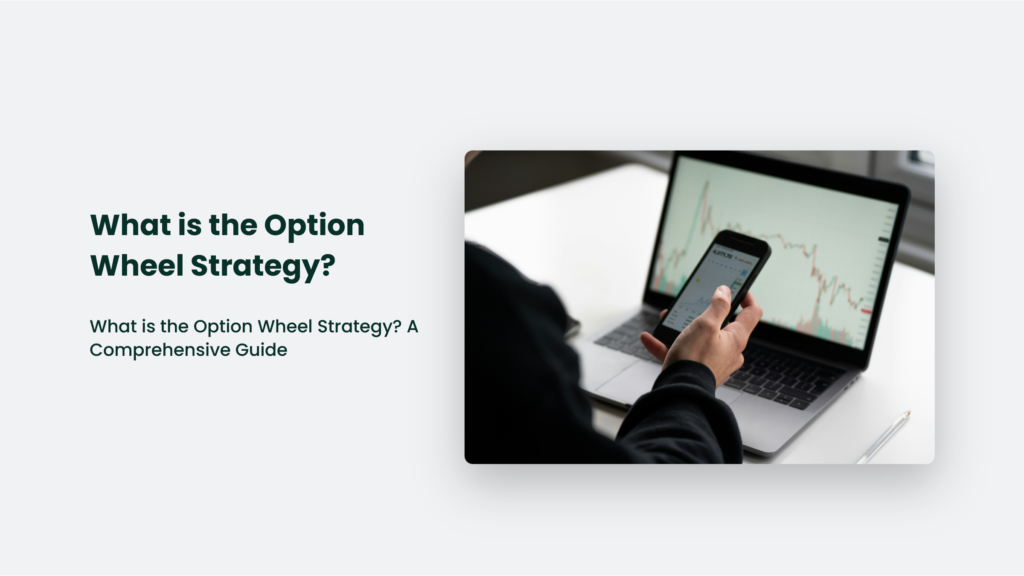Ever feel like you’re spinning your wheels in the stock market? Well, there’s a strategy that embraces that spinning sensation – it’s called the Option Wheel Strategy. This approach to trading options has gained popularity among investors looking for consistent income with a dash of excitement. Let’s dive into the nuts and bolts of what is the option wheel strategy?

What is the Option Wheel Strategy?
The Option Wheel Strategy, sometimes playfully dubbed the “Wheel of Fortune” (minus the flashy lights and Vanna White), is a systematic approach to options trading that can potentially generate consistent income while allowing traders to acquire stocks at a discount. Let’s take a deeper dive into this intriguing strategy and its three key stages.
The Three Stages of the Wheel
Stage 1: Selling Cash-Secured Puts
The journey begins with selling cash-secured puts on a stock you wouldn’t mind owning. It’s like telling the market, “Hey, I’ll buy this stock if it drops to this price, and you’ll pay me for the promise.” Here’s how it works:
- Choose a strike price below the current stock price
- Ensure you have enough cash to buy 100 shares per contract if assigned
- Collect premium upfront
For example, let’s say XYZ Corp is trading at $50. You sell a put with a $45 strike for $2. If XYZ stays above $45, you pocket the $2 premium. If it drops below $45, you buy shares at $45, but your real cost is $43, thanks to the premium.
Stage 2: Stock Ownership (If Assigned)
If the stock price drops below your put’s strike price at expiration, congratulations! You’re now a proud stock owner. But don’t worry, this was part of the plan. Key points:
- You buy 100 shares per contract at the strike price
- Your cost basis is reduced by the premium you collected
Stage 3: Selling Covered Calls
Now that you own the stock, it’s time to sell call options against your shares. This is like renting out your stock with the possibility that the renter might decide to buy it. Here’s the process:
Choose a strike price above your cost basis
- Collect more premiums, further reducing your cost basis
- If the stock is called away, you profit and can start the Wheel again
The Wheel in Motion
The beauty of the Option Wheel Strategy lies in its cyclical nature. It’s like a financial merry-go-round, where each stage flows seamlessly into the next:
- You start by selling puts, collecting premiums and potentially acquiring stock at a discount.
- If assigned, you own the stock at a lower effective price than when you started.
- You then sell covered calls on your newly acquired shares, generating more income.
- If your shares are called away, you’ve made a profit and are back to step 1.
This cycle can continue indefinitely, potentially generating consistent income and allowing you to acquire stocks at favourable prices.
Advantages of the Option Wheel
The Option Wheel Strategy offers several benefits:
- Consistent Income: By continuously selling options, traders can generate regular premium income.
- Reduced Cost Basis: If assigned stock, the premiums collected from selling puts and calls lower the overall cost of owning shares.
- Flexibility: Traders can adjust their strategy based on market conditions and personal risk tolerance.
According to a survey by the Options Clearing Corporation, about 23% of options traders use strategies involving selling puts or calls, including Wheel Strategy variations.
Considerations and Risks
While the Option Wheel Strategy can be effective, it’s important to understand the potential risks:
Capital Intensity
The strategy requires a substantial amount of capital, which can limit its accessibility and flexibility:
- Cash-secured puts demand full collateral, tying up significant funds that could be used elsewhere.
- For example, selling a put on a $100 stock requires $10,000 in cash reserves per contract.
- This capital requirement can limit diversification and reduce overall portfolio returns.
Limited Upside Potential
While the strategy generates consistent income, it caps the maximum profit potential:
- Covered calls limit gains on stock price increases beyond the strike price.
- In strongly bullish markets, the strategy may underperform, simply holding the underlying stock.
- Traders miss out on significant upside moves, which can be substantial for growth or momentum stocks.
Downside Market Risk
The strategy is vulnerable to sharp declines in the underlying stock price:
- If assigned on a put option, the trader may end up owning shares at above-market prices.
- Continued declines can lead to significant paper losses that premiums may not fully offset.
- In severe bear markets, losses can accumulate rapidly across multiple wheel positions.
Opportunity Cost
Focusing on the wheel strategy may mean missing out on other opportunities:
- Capital tied up in wheel trades cannot be deployed in potentially more profitable strategies.
- The strategy’s steady but modest returns may lag behind overall market performance in bull markets.
- Time spent managing wheel positions could be used to identify other high-potential trades.
Assignment Risk
The possibility of early assignment can disrupt the strategy:
- Unexpected assignments on short puts can lead to unplanned stock ownership.
- This may occur at inopportune times, such as before Affiliate Marketing for Dummies: Start Earning Passive Income Now” data-wpil-monitor-id=”1214″>earnings announcements or during market volatility.
- Early assignment on covered calls can result in unexpected stock sales and potential tax consequences.
Volatility Exposure
The strategy’s profitability is sensitive to changes in implied volatility:
- Decreases in implied volatility can reduce the premiums received from selling options.
- In low-volatility environments, the income generated may not adequately compensate for the risks taken.
- Sudden spikes in volatility can increase the likelihood of assignment or result in larger paper losses.
Remember, the Wheel isn’t a get-rich-quick scheme but a systematic approach to navigating the options market. Like learning to ride a bike, it might take some practice to get the hang of it, but once you do, you might find it a smooth and enjoyable ride.
As with any investment strategy, it’s crucial to understand the mechanics and risks involved before implementation thoroughly. The Option Wheel Strategy can be a powerful tool in the right hands, but it requires careful consideration and management to be truly effective.
Disclaimer: The information provided in this article about the Option Wheel Strategy is for general informational and educational purposes only. It should not be construed as financial advice, investment recommendations, or a solicitation to buy or sell any securities or financial instruments.
Frequently Asked Questions:
What’s the ideal market condition for the Option Wheel Strategy?
The strategy tends to work best in sideways or slightly bullish markets. Extremely volatile or bearish markets can pose challenges.
Can I use the Option Wheel Strategy in my retirement account?
Yes, many retirement accounts allow options trading, including selling cash-secured puts and covered calls. Check with your account provider for specific rules.


![The ‘Giveaway Piggy Back Scam’ In Full Swing [2022]](https://www.cjco.com.au/wp-content/uploads/pexels-nataliya-vaitkevich-7172791-1-scaled-2-683x1024.jpg)

